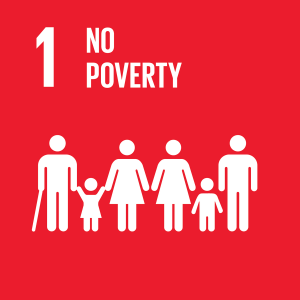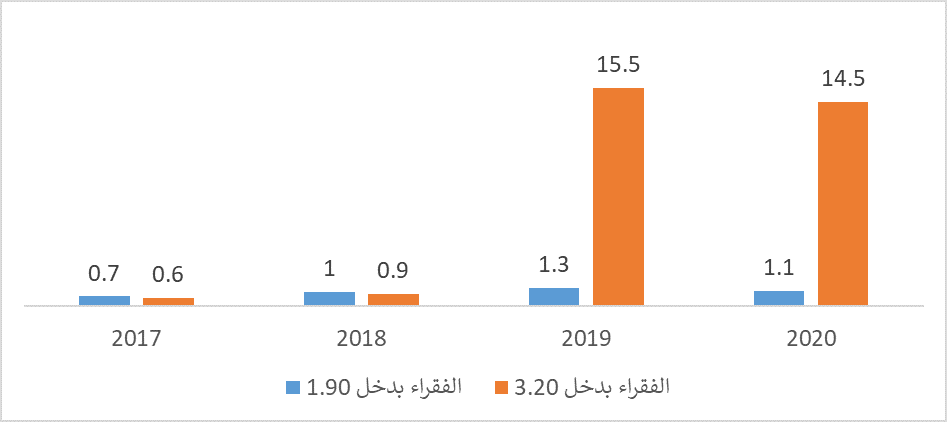Goal 1: End poverty in all its forms everywhere


Poverty in all its forms remains the biggest obstacle to achieving sustainable goals. In Iraq, the proportion of the population below the national poverty line reached 22.5%, according to 2014 estimates. Iraq seeks to reduce poverty through its Poverty Reduction strategies, which aim to reduce poverty by 75% by the end of 2030. The first strategy, 2018-2022, aimed to reduce poverty by 20% for the mentioned period, focusing on three main elements in its programs and activities:
. Creating income-generating opportunities: creating jobs and businesses for the poor, which requires the concerted efforts of the government, the private sector, and civil society.
. Empowerment and building human capital: enabling the poor to realize and exercise their economic, social and political rights, rehabilitate them and build their capacities to integrate them into economic activity.
. Social protection: establishing an effective social safety net in which the private sector and civil society contribute and the adoption of targeting mechanisms to reach the poor.
The Poverty Alleviation Strategy 2018-2022 adopted about (29) activities within five main outcomes, specialized in creating higher and sustainable income from work, improving the health level, spreading and improving education for the poor, adequate housing and an environment responsive to challenges, and effective social protection for the poor.
In 2014, the government issued Law No. 11 regarding the inclusion of the poor in social protection network subsidies by adopting a protection policy that adopts targeting mechanisms in accordance with an international methodology, as well as increasing the social benefit ceiling for poor families according to the number of individuals and linking the amount annually to the poverty line and inflation rates.
The Iraqi government agreed to establish a social fund for development with technical and financial support from the World Bank, which aims to contribute to achieving sustainable and comprehensive development for local communities, supporting them and enabling them to improve the living conditions and access to services. The fund will support the establishment of infrastructure at the community level and the financing of micro, small and medium projects The Fund builds capacity for the Fund’s team, local administrations and relevant civil society organizations.
The government is currently adopting a program to reform the comprehensive ration card support system to target the poor, as it started implementing a trial environment for a period of three months in one area using the smart card and providing catering materials by the private sector with social protection benefits.
Iraq is in the process of approving a social security law for the private sector and the unorganized sector, with equal benefits and wages for workers in state institutions, which will contribute to reducing the demand for employment in the government sector and encouraging work in the private sector and the unorganized sector.
Despite the gains made within the framework of this goal in 2018, and the approach to achieving it, the exceptional circumstances led to the erosion of those gains and the decline in the developmental achievement as in the Table 1.
Iraq also recorded a significant decline in the population index below the international poverty line, 1.9 dollars per day and 2.3 dollars per day. The percentage of the population below this line increased as a result of the faltering of social policies that led to an increase in fragility and delays in finding a solution to the problem of the displaced as in the Figure 1.
This decline during the years 2019-2020 came as a result of the challenges faced by the state in addressing the issue of poverty, unemployment and other social issues, which further complicated the situation and the inability to develop solutions that would enable the desired progress. In comparison, in 2017 and 2018, Iraq achieved acceptable levels. Significantly in the indicators of achieving the first goal, and this is due to the package of measures included in the poverty alleviation strategy, including the Social Fund for Development, and the expansion of social protection (i).
However, more than 3.3 million have benefited from the response of Iraqi civil society and local volunteer groups to the pandemic, including through the distribution of food baskets. Mainly youth-led volunteer groups used innovative means, implemented humanitarian aid, coexistence and community awareness raising activities, and were able to reach vulnerable populations in need.
| The Year | The poverty line
(Dinar) |
Poor Ratio
(%) |
No. of Poverty
(Population) |
|
| Al-Qaeda shock and insecurity | 2007 | 76896 | 22.4 | 6.648 |
| 2012 | 105500 | 18.9 | 6.465 | |
| Pre- ISIS | 2014 | 105500 | 16.0 | 5.760 |
| ISIS shock | 2014 | 105500 | 22.5 | 8.101 |
| 2018 | 110880 | 20.5 | 7.370 | |
| Covid-19 shock | 2020 | 111000 | 31.7 | 12.680 |
| Fixed General Social Transfers Scenario
(1,190 dinars/dollar) |
2020 | 111000 | 26.7 | 11.170 |
| If the exchange rate changes
(1470 dinars/dollar) |
2021 | 115000 | 29.6 | 12.271 |
Source: Second Voluntary National Report p. 38


Source: Second National Voluntary Report p. 39
